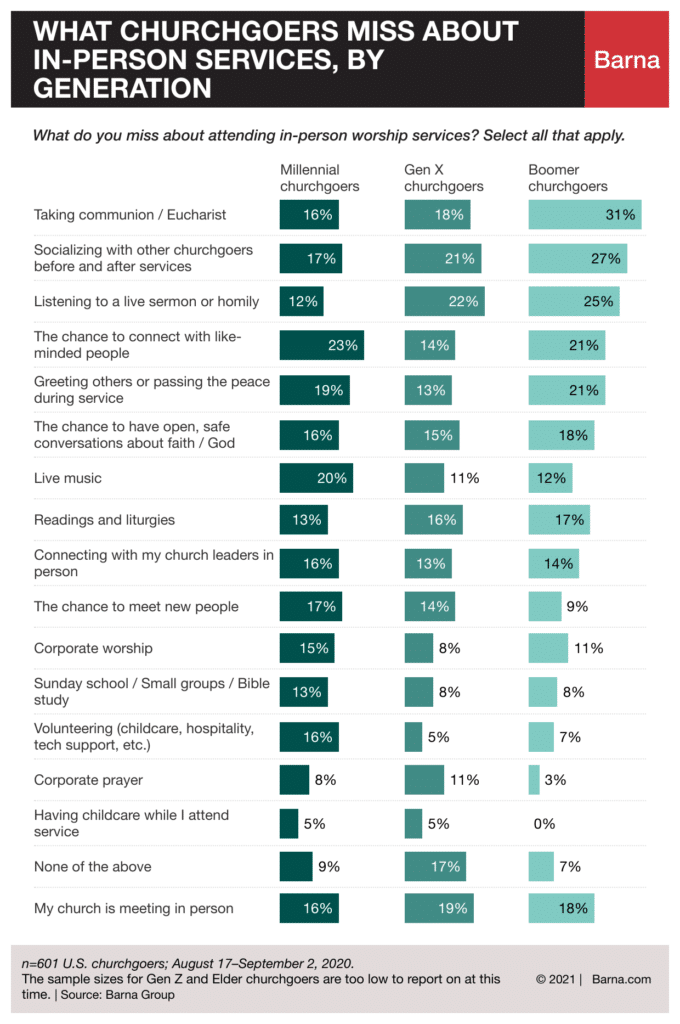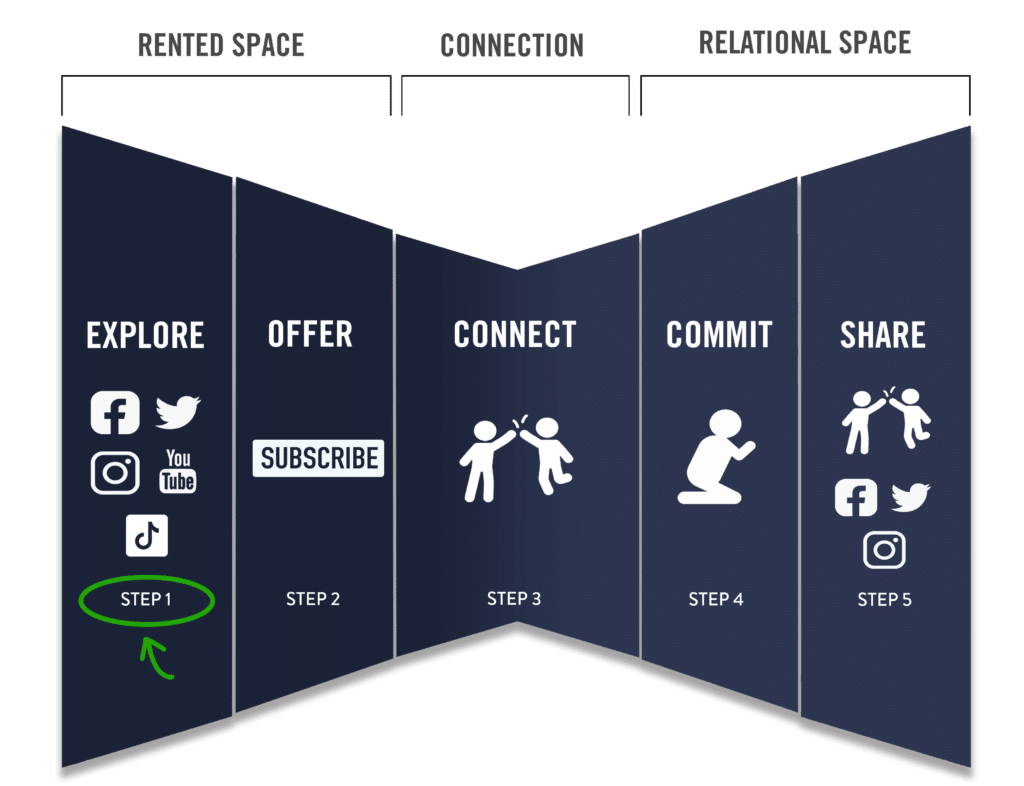3 Things That Will Be True About Growing Churches In The Future
This article was originally published on careynieuwhof.com
There’s no question everything in ministry has shifted in the last eighteen months. But the real question is how?
Some things, of course, never change. The mission of the church is as critical as ever. The need for prayer, scripture, preaching, love, community, grace, forgiveness, and hope is as sharp as ever.
And yet church leaders are struggling with how to connect with a deeply changing culture and reality.
As church leaders prepare for a full hybrid future, which will feature both digital and in-person ministry, it’s not exactly clear what in-person services will offer that digital ministry doesn’t (and vice versa).
As the Barna poll results below demonstrate, everyone did not miss the same thing when church went online in 2020-2021.
Boomers missed different aspects of in-person church than Millennials.

One trend is that people miss connecting with other people, which is completely understandable.
In addition, live music is more important to Millennials than to Boomers. And in-person preaching seems to be missed more by older adults than those under 40.
In another Barna survey, 67% of respondents say they learn just as much from a streamed message as from an in-person sermon.
It’s still, of course, early days in terms of how all of this will fall out in the future, but looking at the trends, here are a few things that I sense will be true of growing churches in the future, both online and in-person.
1. Digital Ministry Will Be About Genuine Connection
Future ministry is hybrid ministry.
If digital ministry (the online side of hybrid) is going to do what’s it’s designed to do, it will become about genuine connection.
Right now, many churches are using digital ministry for content distribution via YouTube and social, but in its fullest form, digital ministry is about people.
Ultimately, the goal of digital content is not consumption, it’s connection and community. The goal is NOT the number of: followers, views, minutes watched, likes, comments (as significant as they might be).
Content alone doesn’t lead to engagement. Community and connection do.
The graphic below is a model for a Digital Engagement Funnel for churches that shows how to move someone who clicks on your content to a true connection and relationship.

The five steps move people from just watching or reading your content to connection, engagement, and then commitment (to Christ) and, finally, for them to share their faith with others.
The challenge is, right now, most churches have only explored Step 1. They post content and haven’t figured out how to move much past that.
It’s a great first step, but real-life change happens when you move into connection and relationship.
Being online is one thing. Connecting with people online and moving that into real-life relationships is quite another.
2. An Experience OF God Will Replace Information ABOUT God
Attractional church has seen thousands, probably millions, of people move into an authentic relationship with Jesus. Please hear that.
But sometimes what we’ve done (I say “we” because I’ve done this) is we tend to share information about Jesus or Christianity when we preach or host services. There was a day when that was really helpful, and that’s still not an entirely bad instinct. Who, after all, wants to lose people completely?
But remember, we now have the full-on internet that swallows daily life whole. We are drowning in a sea of information.
Fast forward to church, and guess what? People aren’t looking for information. They’re looking for transformation.
When people come to your church these days, fewer are looking for information about God; they’re looking for an experience with God.
Both the digital explosion and the cynicism of our age have left people hungering for a transcendent touch. Think about the explosive rise of porn. People are looking for intimacy, but of course, in porn, get just the opposite. They’re looking for more.
People are hungry for true community, deeper experiences, and authentic transcendence.
This is why churches that are growing are focusing more and more on creating experiences that engage more than just the head on a Sunday…but also engage the heart and relationship.
In short, people don’t just want to know what’s true, they want to know what’s real. And what’s real is deeper than just an idea—it’s an experience.
They come looking for something bigger than themselves and, frankly, bigger than us. They come looking for God.
It’s a shame when people come to church looking for God and only find us.
God, in his nature, is both immanent and transcendent. A few decades ago as the culture slipped away from church, focusing on the imminence of God brought many back.
But the cultural shifts of the last decade and a half have left people (especially younger people) longing for the transcendent.
This should be no surprise because of course the heart naturally longs for God. Sometimes we just long for God a bit differently than our parents.
I think the best future churches will have content that leans toward the immanent—practical, helpful, and digestible. Again, being completely obtuse and incomprehensible or insider-focused helps no one. And future churches will also offer experiences that feel transcendent…a sense that you had to be there to experience what happened.
The best churches will offer both because that reflects the character and nature of God and the character of the Christian church at its best.
3. Future Churches Will Go to People, Rather Than Expect People to Come to Them
Historically, the church has wagered almost everything on gathering people in a building.
In the future, growing churches will focus less on gathering and much more on going to where people are.
A small example.
I interviewed Simon Sinek on my Leadership Podcast. Usually, toward the end of the episode, I’ll ask the guest where people can connect with them online.
Simon’s answer was untraditional but resonated immediately.
My responsibility is not to tell you where to get my stuff. My responsibility is to put my stuff wherever you are. So some people use one platform, someone uses another, and I try and share my work wherever you are. So wherever you go, I’m probably there.
Did you catch that? So wherever you go, I’m probably there.
It’s a really great point. Church leaders today should be taking notes.
In many ways, the first-century church was a church that met wherever people were. In the future, church will be much more like that, digitally, through central gatherings and micro-gatherings.
Companies like DoorDash, Amazon, Brooklinen, Peleton, and other companies have realized going to where people are is a great strategy.
Connecting people who are engaging from home both with the church and with one another will become an essential skill for all church leaders.
The easiest way to think about this is the same way church leaders have thought about small groups for the last 25 years.
Almost no church leader today feels threatened by the idea that hundreds–or thousands–of people will be meeting in their homes to connect with other people. The church facilitates groups but doesn’t host them in a centralized facility.
Instead, leaders simply connect people who want to be connected and engage them in the mission.
This is where the potential for Sunday morning starts to move in a new direction.
Small groups by nature tend to be closed and intimate. Gathering in people’s homes and outside the building on Sunday morning (or off-Sunday) would consist of micro-churches that are outward-focused. Think of groups, but with an evangelistic thrust.
Gathering people on Sunday mornings will be as important as ever. It just won’t all happen in a building owned by the church.
